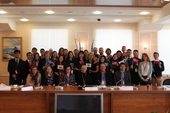IGERT Story
A Week as an Arctic Council Delegate in Arkhangelsk, Russia
Description
Given the increasing interest in the Arctic—from the international scientific, business, and health communities—it seems fitting, and perhaps even imperative, to expose the next generation of policymakers to the inner workings of Arctic diplomacy. During the last week of February, I had the privilege of representing the United States and Dartmouth College at the first ever Model Arctic Council, a role-playing conference with the same goals as the well-known Model UN: expose students to high-level policy negotiations through experience and participation.
The Northern Arctic Federal University (NArFU) in Arkhangelsk, Russia hosted 30 graduate students from over 10 countries to simulate the proceedings of the Arctic Council, the high level intergovernmental forum through which Arctic governments and indigenous peoples discuss and take tangible actions to address the economic, social, health, safety, and security issues that they face.
Day one of the four-day program consisted of lectures and round-table diplomacy discussions led by prominent government figures: US Embassy Public Affairs Officer Steven Labensky, Russian International Affairs Council Deputy Program Director Timur Makhmutov, and Dr. Lev Levit of the Arctic Council Secretariat. Additionally, students engaged in lectures by Arctic experts in academia: Prof. Hitchins of University of Alaska spoke on the history of the Arctic Council, Prof. Nord of Western Washington University shared his tremendous insights on the changes in and challenges for the Council from his involvement over the past two decades; and Prof. Alexander Sergunin of St. Petersburg State University lectured on international relations and security strategies.
The following days involved simulations of the three types of meetings run by the Council: a biannual meeting for one of the six Working Groups, which implement research and projects related to specific interests like sustainable development; the biannual meeting of the Senior Arctic Officials; and the biennial meeting of Arctic Ministers (the Secretary of State represents the US in this meeting). Each was a progressively higher-level meeting to which participants passed along information discussed and resolved at the lower-level meeting the previous day. Students followed the Council’s Rules of Procedure while representing delegates from the 8 Arctic States, 6 Permanent Participants of indigenous groups, 4 of the 6 Working Groups, and 3 of the 12 non-Arctic observer states. Each role was assigned prior to the meeting, and students prepared written position papers as well as oral statements or presentations for the meetings. I was selected to role-play the chair of the PAME working group (Protection of the Arctic Marine Environment) and ensured that environmental management, pollution control, and ecosystem protection entered the conversations. Specifically, I updated the Senior Arctic Officials on the progress of a new Arctic Marine Shipping Plan, a collaborative sustainable tourism initiative, and potential special designation of Arctic marine areas.
The Model Council’s task and final product was the “Arkhangelsk Declaration.” Emulating those produced every two years at the Arctic Council Ministerial Meetings, this document highlights progress and outlines future goals we agreed upon by consensus. Specifically, the Declaration summarized our work creating and designing initiatives to revitalize indigenous language, facilitate international electronic sharing of historical archives and data, stimulate product development within the reindeer herding industry, and address the incidence of suicide in Northern communities. Overall, the discussions were engaging, the negotiations successful, and the resulting plan both compelling and achievable.
The exercise was also characterized by some of the challenges the real Council faces: miscommunications resulting from varying levels of English proficiency, gridlock due to conflicting interests and opinions on financial obligations, and vastly different relevance of issues to each country or participant. At the end, I left with a working knowledge of the operating procedures and current priorities of Arctic Council that could not be acquired through lectures or reading. More importantly, however, I departed Arkhangelsk with a profound, almost humbling, sense of optimism about the potential for even greater international collaboration and the commitment of my generation of students to ensuring a profitable, peaceful, and thoughtfully-developed future for the Arctic region.
I was able to attend the Model Arctic Council thanks to the generosity of Dartmouth’s Institute of Arctic Studies at the Dickey Center for International Understanding and NArFU.








